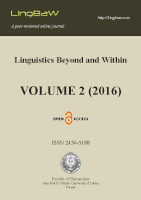Asking and answering: A contrastive study of English and Swedish basic communication verbs
Asking and answering: A contrastive study of English and Swedish basic communication verbs
Author(s): Åke VibergSubject(s): Semiotics / Semiology, Morphology, Lexis, Cognitive linguistics
Published by: Wydawnictwo KUL
Keywords: corpus-based contrastive study; lexical semantics; FrameNet; English; Swedish; Verbal Communication verbs;
Summary/Abstract: This article presents a contrastive study of the English verbs ask and answer and their Swedish correspondents based on data from the English Swedish Parallel Corpus (ESPC), which is bi-directional and contains Swedish and English original texts and their corresponding translations. As a background, a short overview is given of Verbal Communication Verbs (VCVs) in general with brief discussions of speech act theory (Searle), direct and reported speech and conceptual frames (FrameNet) and their syntactic realizations. The contrastive study is concerned with networks of polysemy and the relationships of various senses with differing syntactic realizations across languages. The senses of ask are primarily distributed between two verbs in Swedish: fråga ‘ask a question’ and be ‘request (politely)’ but even some verbs with more specific meanings are involved. The concept of answering forms a conceptual network which is similar in English and Swedish but contrasts with respect to the way meanings are divided up between various verbs. English has a number of verbs such as answer, reply, respond, correspond, retort and rejoin, whereas Swedish to a great extent relies on one verb (svara) and its morphological derivations: besvara, ansvara, motsvara, försvara. In the Conclusion, pedagogical applications of the study are briefly discussed.
Journal: Linguistics Beyond and Within (LingBaW)
- Issue Year: 2/2016
- Issue No: 2
- Page Range: 180-212
- Page Count: 33
- Language: English

